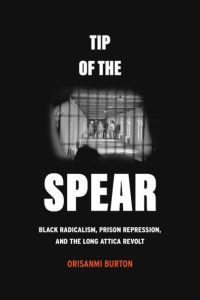Tip of the Spear: Black Radicalism, Prison Regression, and the Long Attica Revolt
 Author: Orisanmi Burton
Author: Orisanmi Burton
Publisher: University of California Press, 2023. 328 pages.
Reviewer: Andrew Baer | September 2024
The revolt inside New York state’s Attica Prison in September 1971 is best viewed as part of a larger movement of collective struggle among state prisoners in the United States and beyond. This movement was led by a small, but influential number of lesser-known Black radicals whose vision of a nation—indeed, a world—devoid of cages, “patriarchal white supremacy,” and “globalized empire” left an enduring legacy among prison abolitionists and others into the twenty-first century (115). By prioritizing the voices, ideas, and actions of Black radicals at Attica and elsewhere from the late 1960s through the 1970s, Orisanmi Burton’s Tip of the Spear not only chronicles an important history, but recovers some of the more inspiring visions espoused by a group of people—radical Black prisoners—who were marginalized by the state and, according to the author, by scholars as well.
Burton covers some familiar ground, but in a unique way. Whereas other scholars have focused more on the what Burton calls the “minimum demands” of prison revolt—improved living conditions and other practical concerns—Burton focuses more on the “maximum demands” expressed by prison rebels—abolishing prisons, ending colonialism, and eradicating white supremacy (5). If observers, then and now, often dismissed these abstract goals as impractical, Burton takes them seriously, insisting that the grand ambitions of prison rebels in this period represent an enduring vision of meaningful freedom, a world without walls that his subjects truly aspired to and that has inspired activists up to the present day. To state prisoners of the Black Power era, prison protests were not directed exclusively—even primarily—toward improving day-to-day conditions within prisons, but were directed toward transforming the larger world that created prisons in the first place. “Although they erupted within prisons,” Burton argues, “these rebellions looked beyond them” (14).
Burton also takes seriously the Attica rebels’ embrace of armed self-defense, debates over political violence, and construction of a makeshift arsenal in D yard. Whereas other observers sanitize the rebels’ complex relationship to violence, Burton laudably approaches these issues on the terms set by his historical subjects. Acknowledging that prison systems represent a literal war against poor and non-white communities, Burton and his subjects consider the efficacy of fighting state violence with revolutionary violence. After all, prisons are “site[s] of active combat” (226).
In his effort to differentiate his work from previous publications, however, Burton occasionally overstates his critique of other scholars of the Attica Rebellion, particular when he refers to their books as a “counterinsurgent historiography” (8, 52). While Burton’s critique is valid, his word choice seems unfair to this reader, as it accuses other researchers of deliberately working with the state or consciously undermining the prison abolition movement. The author is most persuasive when highlighting how other writers missed important sources or failed to prioritize radical voices. Whether this is counterinsurgent is up for debate. While Heather Ann Thompson’s Blood in the Water receives a fair amount of critique throughout, Burton’s and Thompson’s work appear more complementary than antagonistic. Burton’s complex—often bold and revelatory—analysis adds a great deal to Thompson’s rich narrative. If Thompson’s work reveals how awful Attica was, Burton’s shows that it was much worse than previously imagined.
Overall, this is an excellent book that is well-researched, well-written, and abundantly sourced. The author’s recovery of radical voices provides an important contribution to previous work on a subject with clear significance for ongoing struggles to abolition prisons in the U.S. and beyond. Indeed, as Burton argues, the limited experiment in radical democracy that Black radicals and their allies established in Attica prior to the state’s violent retaking of the prison created a “blueprint for an abolitionist world that future generations can study and learn from” (91).
Andrew S. Baer is an Associate Professor of History at The University of Alabama at Birmingham.


